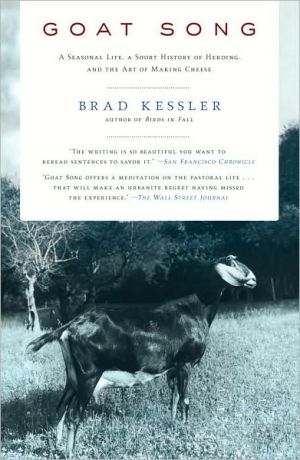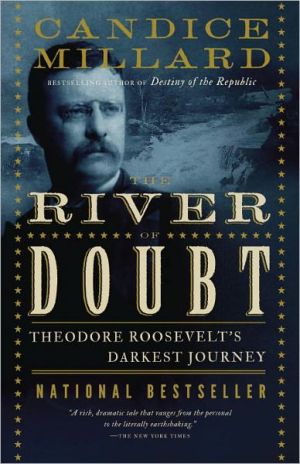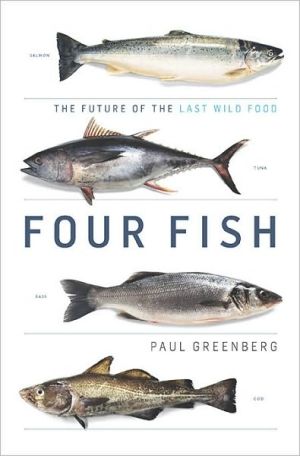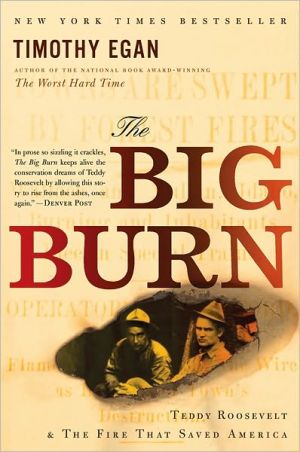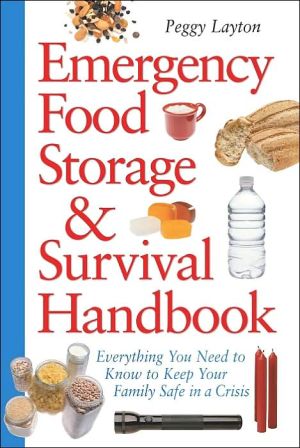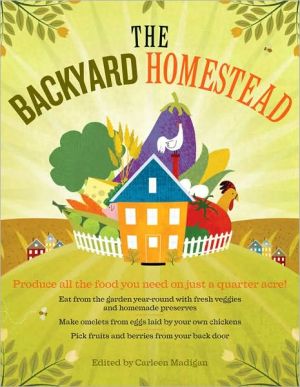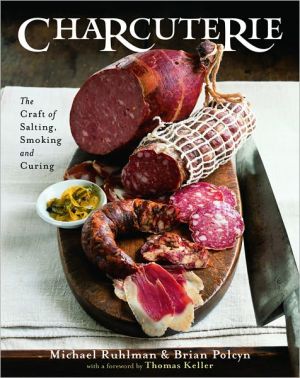Goat Song: A Seasonal Life, A Short History of Herding, and the Art of Making Cheese
Acclaimed novelist Brad Kessler lived in New York City but longed for a life on the land where he could grow his own food. After years of searching for a home, he and his wife, photographer Dona Ann McAdams, found a mountain farmhouse on a dead-end road, with seventy-five acres of land. One day, when Dona returned home with fresh goat milk from a neighbor's farm, Kessler made a fresh chèvre, and their life changed forever. They decided to raise dairy goats and make cheese.\ Goat Song tells...
Search in google:
Novelist Brad Kessler's beautiful account of how he abandoned his life in New York to raise goats and make cheese in Vermont. Publishers Weekly Novelist (Birds in Fall; Lick Creek) Kessler's account of tending a small herd of milking goats in Vermont captures both the lush, poetic paradise of rural life and the raw, unrelenting drama of dairying. Kessler, a Saab-driving ex-Manhattanite, purchases two Nubian goats, breeds them and helps his wife, Dona, a trained doula, attend to the birth of four goat kids the following spring. The amusing zoomorphic and anthropomorphic descriptions, where goats forage as if they were at a sample sale and milk-fed kids stagger "like street junkies," dissipate as Kessler endures a season of goat wrangling, haying and hunting coyotes. Kessler gives the legal aspects of unpasteurized cheese a cursory inspection; his devotion centers on a budding relationship with animals, the earth and goat cheese. He's a back-to-the-land naturalist, who supports his detailed personal observations with extensive research as he explores the cultural, historical and biological aspects of pastoralism. While the tome's lengthy poetic journal entries on animal husbandry and cheese making hardly qualify as a comprehensive manual, the observant, unsanctimonious read is bound to inspire hobby farmers and consummate cheese lovers. (June)Copyright © Reed Business Information, a division of Reed Elsevier Inc. All rights reserved.
Beginnings\ Years ago I fell in love with a farmhouse in West Virginia. The house sat at the head of a hollow — wide-board floors, a rusted tin roof — the last outpost before impassable mountains. You drove up a dirt road beside a murmuring creek and came to a cattle gate. When you hooked the gate again it felt like you were leaving the world behind.\ I lived in Manhattan back then but never felt right in the city. I longed for fewer people and more trees. The rented farmhouse was an anodyne. Between semesters and on long weekends my wife, Dona, and I escaped to West Virginia. I adored the long drives, the eight-hour commute, the layers of Manhattan peeling away with each Mid-Atlantic state — New Jersey, Pennsylvania, Maryland, Virginia. It felt like stripping out of formal attire; by the Alleghenies we were down to underwear.\ We were about to shake hands on the West Virginia farmhouse when a phone call came one night. The seller had burned down the house. Turned out he never really owned the homeplace — his sister did. He burned the house for spite. A family feud. An Appalachian story. The night the call came I mourned, convinced we'd never find such a perfect place again.\ My whole life it seemed I'd been searching for a retreat in the mountains, a patch of land where I could grow my own food. I was a writer, Dona a photographer. We made our living — our art — with paper but we longed to make it with earth as well. Ever since reading Walden as a teen I'd nursed Thoreau's old dream of self-reliance, his cabin along the lake, his meticulous lists of peas and beans. I admired how he wove literary culture and agriculture into one fabric — pen in one hand, hoe in the other — and how he understood that alongside civil disobedience, the most active thing one could do on earth was produce one's own food.\ For five years we searched for a home. We scoured the whole Northeast, looked at a hundred plots of land. One week a realtor called from Vermont. He'd found an eighteenth-century farmhouse on a dead-end road in the western part of the state. The asking price was absurdly low; the farmhouse had sat empty for years and nothing inside was expected to work. We might have to tear the place down, he confessed, and start anew. Yet the land was apparently stunning, worth the asking price alone. There was an orchard, a pond, outbuildings, a brook. Seventy-five acres of sheepland grown back to forest.\ We drove there late one October afternoon when the trees had shed their leaves. The valley looked promising; narrow and forested with folded hills. An opalescent river tumbled aside the road. The pavement turned to gravel, then we jostled up a rocky drive and the house swung into view: bone white clapboards, mountains all around. We both knew right away.\ This was over a decade ago. Back then neither of us knew much about animal husbandry (we'd both grown up in the suburbs). But soon Dona began photographing neighboring dairy farms and helping with chores; and that led to a familiarity — a friendship — with animals, particularly with goats.\ This is the story of our first years with dairy goats. A story about what it's like to live with animals who directly feed you. I tell of cheese and culture and agriculture, but also of the rediscovery of a pastoral life. Rediscovery because the longer I lived with goats the more connections I saw to a collective human past we've since forgotten, here in North America at least. I saw how so many aspects of our everyday culture — from our alphabet to our diet to elements of our economy and poetry — arose from a lifestyle of herding hoofed animals, and how unbeknownst to most of us, pastoralism still informs so much of the way we live today.\ Goats had intrigued me for years — their intelligence, their seeming disdain of human dominion. I once trailed a herd of goats in India through the Thar Desert back to their homes at night. A herder led them into the walled city of Jaisalmer. The goats marched single file, hoofs clicking cobbles, while scooters and trucks squeezed past. At each narrow curve another doe broke from the parade and turned in to a home where a member of the household — a child or a woman — held open a wooden door and greeted the returning goat with a palmful of salt. The does had returned from the desert to be milked and bedded with their family at night. In the morning they'd gather again with the herder. I'd never seen such a wonderful arrangement before — goats and humans living side by side — but it was one of the most ancient continuous relationships between mammals.\ In Vermont, Dona milked a neighbor's goats when the neighbor went away. She brought home the raw milk still warm in a glass bottle. I made a queso blanco, the simplest cheese in the world. (You heat the milk, add a spoonful of vinegar, and the curds separate from the whey like magic; drain the curds in a cheesecloth, let them drip for a few minutes and — voilà — you've made a cheese.) The queso blanco was tasty but a bit rubbery. When the neighbor went away again I tried my hand at making chèvre. I had a small bottle of rennet and the right starter culture. The curds set up overnight and the next day I drained them in a cheesecloth. When we tried the fresh chèvre the following afternoon, it tasted like nothing we'd ever eaten before — a custard, a creamy pudding, the cheese so young and floral it held within its curd the taste of grass and herbs the goat had eaten the day before. It seemed we were eating not a cheese, but a meadow.\ The French used to call cheese "the drunkard's biscuit." That afternoon we were intoxicated without drinking a thing. We devoured the creamy chèvre smeared on slices of bread, ran fingers across the plate. We couldn't understand why it tasted so good. Was it the raw unpasteurized milk, or that we knew the goats — their labor and ours? "Who has not sometimes derived an inexpressible satisfaction from his food, in which appetite had no share?" wrote Thoreau. "I have been inspired through the palate."\ That afternoon we decided: it was time to get our goats.\ Copyright © 2009 by Brad Kessler
\ From Barnes & NobleBrad Kessler's account of his transformation from being a New York City apartment dweller into a Vermont goat herder has all the attributes that have made his award-winning novels (Birds in Fall) and children's books (Firebird) so enthralling. This chronicle of a year living by nature's rules is enlivened by Kessler's keen observations and lyrical writing style, making it worthy of comparison with books like Annie Dillard's Pilgrim at Tinker Creek. And the close-up looks at dairy goats and cheese making lend it special appeal for animal lovers and food fanciers.\ \ \ \ \ Publishers WeeklyNovelist (Birds in Fall; Lick Creek) Kessler's account of tending a small herd of milking goats in Vermont captures both the lush, poetic paradise of rural life and the raw, unrelenting drama of dairying. Kessler, a Saab-driving ex-Manhattanite, purchases two Nubian goats, breeds them and helps his wife, Dona, a trained doula, attend to the birth of four goat kids the following spring. The amusing zoomorphic and anthropomorphic descriptions, where goats forage as if they were at a sample sale and milk-fed kids stagger "like street junkies," dissipate as Kessler endures a season of goat wrangling, haying and hunting coyotes. Kessler gives the legal aspects of unpasteurized cheese a cursory inspection; his devotion centers on a budding relationship with animals, the earth and goat cheese. He's a back-to-the-land naturalist, who supports his detailed personal observations with extensive research as he explores the cultural, historical and biological aspects of pastoralism. While the tome's lengthy poetic journal entries on animal husbandry and cheese making hardly qualify as a comprehensive manual, the observant, unsanctimonious read is bound to inspire hobby farmers and consummate cheese lovers. (June)\ Copyright © Reed Business Information, a division of Reed Elsevier Inc. All rights reserved.\ \ \ Library JournalNovelist and journalist Kessler (Birds in Fall) introduces us to a more personal side of his life—his life with goats. But this book is more than just a memoir. As Kessler recounts the early years when he and his wife moved from Manhattan to a farm in Vermont where they raised goats, he intricately intertwines the relationship humans and goats have had throughout history, pulls in several literary works that inspired him, and takes readers back to the roots of the pastoral lifestyle. This pleasant and poignant book journeys between present and past, demonstrates the delights and challenges of raising goats, and explains how fresh milk and cheese can make the effort worth undertaking. VERDICT Whether experienced with goats or not, readers will appreciate Kessler's ability to weave explanatory passages into his text to enlighten and promote an understanding of the herding way of life that continues today. Sure to appeal to urban dwellers thinking about going back to the land.—Kyrille Goldbeck, Virginia Polytechnic Inst. & State Univ., Blacksburg\ \ —Kyrille Goldbeck\ \ \ \ \ Kirkus ReviewsNovelist Kessler (Birds in Fall, 2006, etc.) chronicles the time he and his wife spent among dairy goats in rural Vermont. Burned out from the daily grind of New York City, Kessler and his wife Dona purchased a 75-acre parcel of land to establish a working goat farm. The author details their foray into pastoral living with all the imagery and polished word choice one would expect from a practiced novelist. From the daily challenges and rewards of acquiring, shepherding, breeding and milking Nubian goats and birthing young kids, to their first experience with cheese-making, Kessler's account serves as a user-friendly how-to manual on goat farming. The author also delves into the foundations and history of goat keeping, the predator/prey relationship (as he tracks the coyotes that are frequenting his barnyard) and man's quest for a spiritual connection with other creatures and the land that sustains him. The book is more than just a story of escape from urban monotony; it's also a detailed diary of the transformative effects of a new beginning. Because the entries don't always cohere as a chronological narrative, the chapters are short, conclusions are somewhat choppy and the material, while interesting, is exceedingly quiet in tone. Nonetheless, Kessler pleasingly echoes the work of Annie Dillard and Georgeanne Brennan's A Pig in Provence (2007). A hushed, meditative tribute to the nearly forgotten value of living off the land. Agent: Bill Clegg/Burnes & Clegg\ \
